From endless ambient Eno to Hawking in your pocket, iOS devices have dramatically changed how we interact with media
Throughout history, technology has changed how people experience media. Home recordings shifted music and screen-based entertainment away from live gigs and cinemas. Then VHS tape decks freed people from needing to be present at a specific time to enjoy broadcasted shows. Later, CD and DVD eroded linearity – no longer did you have to wind through a tape to get to the bit of a recording you wanted.
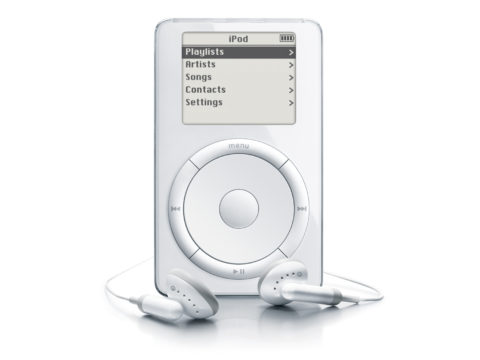
Apple played its part, too. The iPod wasn’t the first digital music player, but it was the one that captured the world’s imagination. A jukebox in your pocket, iPod revolutionized the music industry – before the industry was further reshaped by streaming. But music is just one type of media. Arguably, the iPhone and iPad had an even greater effect, with apps changing the way in which musicians, filmmakers and authors present their work.

In being a portable computer connected to the internet, with a superb screen, and multitouch input, the iPhone was a truly disruptive, trailblazing device – and remains so. As we’ll explore in this feature, it’s enabled a range of truly disruptive, trailblazing creative experiences unlike anything seen before.
Infinite music
Originally released in 2008, Bloom was one of the first apps to grapple with how mobile devices could impact on music delivery. Developed by ambient music pioneer Brian Eno and musician/software designer Peter Chilvers, it’s a combination of instrument, artwork and composition. Each of your taps on the screen plays a note while a circle of light gradually expands and fades. Eventually, your composition loops.
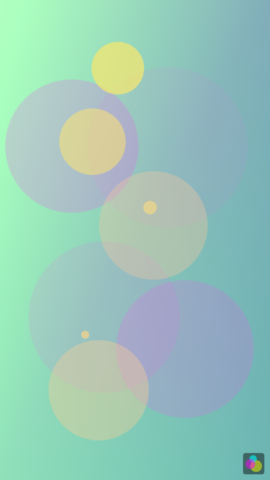
Bloom
But although Bloom was undoubtedly embraced by many as an effortless way to create ambient music, it also has a generative listen mode. In other words, Bloom can play itself, creating endless music within the rules of its system. This in effect was the ‘ambient music dream’ made real – infinite atmospherics, for relaxation, reflection or background.

Brian Eno : Reflection
Eno and Chilvers collaborated several more times before issuing the ambitious Scape – an iPad app for fashioning tracks from musical elements ‘constructed’ on screen. But with 2017’s Reflection, interaction has been stripped away entirely – instead, you simply press play. On doing so, patterns and elements from Eno’s latest album come and go in a kind of endless remix, alongside slowly morphing imagery.
Eno likens this to “sitting by a river” – the whole remains recognisable but it’s never quite the same as it was at any point before. By contrast, the standard album release is limited. The Reflection app subtly shifts and changes over time, with even the sound itself altering at different times of day; the CD or album download is forever static – a video of the river.
Chop and change
Adrian Belew has also found himself deeply immersed in iOS. A long-time member of King Crimson, the acclaimed multi-instrumentalist has also worked with David Bowie and Talking Heads, and so has plenty of insight into the nature of music.
He asserts that to hold someone’s attention today, music should be “quick, surprising and random” and the tracks should “make a statement and move on”. Thus, his FLUX app, subtitled ‘never the same twice’, reflects this fascination with the modern nature of technology and recorded content. Hit play and it blasts out sonic snippets – a randomly chosen selection of musical fragments and imagery from a library that keeps on growing. Songs often reappear, but in different forms, with alternate lyrics and instrumentation.
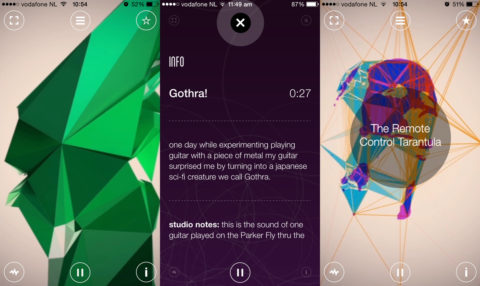
FLUX
In a sense, it’s the antithesis of Eno. Reflection is about iOS enabling endless music to assist in attaining a meditative state, but FLUX is akin to bombardment for short attention spans. But both apps have in common a semi-random, never-repeating, algorithmic foundation – something that simply wasn’t possible in an immersive, mobile way before the iPhone.
Close to the edit
Although mobile devices have also changed the way in which we consume television and movies, much of that is down to portability. From a content standpoint, there’s little inherently different about watching the latest Star Wars on your iPhone than at the cinema. But plenty of developers have utilized apps to go beyond merely pressing play.

The Orchestra
Amphio Limited’s The Orchestra adds context to classical music. Although you can just watch the orchestra play, the app enables you to split the screen to add a rolling score, or become the director and switch between camera views and sections of the orchestra.

Attenborough Story of Life
To some extent, Attenborough Story of Life is in similar territory. The app offers access to over 1000 moments from the career of perhaps the foremost figure in wildlife television. What propels it beyond ‘merely’ being a heap of searchable clips is the option to fashion your own playlists, which can be shared. Again, you become the editor.
Virtual reality
Video in app form affords opportunities for creativity beyond camera and clip selection, though. Google’s psychedelic and often unsettling The Bohemian Rhapsody Experience is best experienced with your iPhone strapped to your face by way of Google Cardboard or a similar VR viewer. You’re then immersed in a journey through frontman Freddie Mercury’s subconscious mind.

The Bohemian Rhapsody Experience
Because of the nature of VR, the experience surrounds you – you can look in any direction and feel a part of what’s happening in a way that just doesn’t happen when watching traditional television.
ARTE’s Notes on Blindness VR utilizes virtual reality as well, but is a more sombre affair. Here, your iPhone removes the bulk of your vision, scenes within the presentation offering only glimpses of light akin to echolocation. The audio then combines the recordings of John Hull, who went blind in 1983, and soundscapes that attempt to capture the world in which he suddenly found himself.
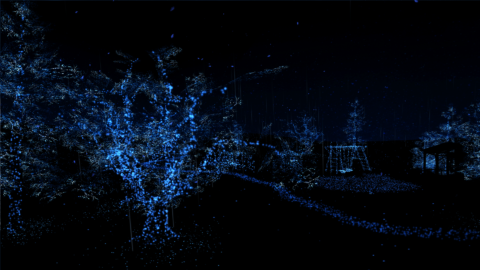
Notes on Blindness VR
Again, this showcases the power of media in app form. You can certainly get a sense of someone’s situation by watching a documentary on the television; but when your experience as closely as possible mirrors that of the narrator, the potential for understanding and empathy hugely increases.
Control the narrative
Another way in which apps have changed media is in their ability to allow you to take control. While this can rob a creator of the ability to dictate pace, it can work nicely for contemplative works, where the aim is to immerse a viewer in a world and have them explore, rather than hurl them through a linear storyline.
ISLANDS: Non-Places is listed on the App Store as a game, but is in reality a series of slightly interactive animations. Each scene – based around a place you tend to travel through rather than consider a destination – can be spun about its axis. Events then mostly occur at your leisure, through you tapping lights and objects on the screen.

ISLANDS: Non-Places
The sense of atmosphere is palpable, and the unusual juxtapositions of mundane objects are at times surreal, menacing and amusing. But ISLANDS mostly works because it affords you that slight degree of control. You can peek and prod, knowing something will happen when you press the screen, building anticipation. The same concepts could have resulted in a perfectly interesting traditional animation, but the effect wouldn’t have been the same with you sitting and watching, rather than exploring and interacting.
A sense of adventure
Being able to more directly control the outcome of what you’re watching is a commonplace theme in apps – and readily apparent as you head further into the overlap between narrative and gaming. Arcadia by Iain Pears features ten characters and three interlocking worlds, and invites readers to structure the book as it best suits them.
From a structural standpoint, this kind of thing will be familiar to people who’ve read gamebooks such as the Choose Your Own Adventure series or Fighting Fantasy. And it’s conceivable that Arcadia could have existed in paper form – although it would have been less elegant. But elsewhere, you see how branching narratives take fuller advantage of digital devices.
80 Days and The Sorcery! series echo the form of paper-based products, but differentiate themselves with inventories, visuals, soundtracks, and rewind features.
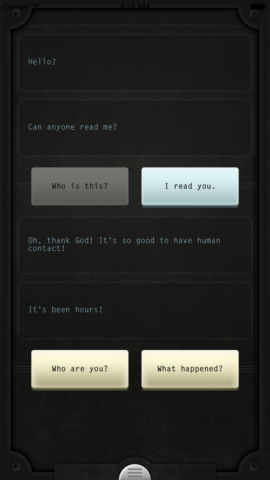
Lifeline…
Lifeline… further removes itself from static paper takes on branching narrative through the use of time. You receive a communication from a stranded astronaut and help through making decisions on their behalf. But when a task is long, it may be hours until your next communication, ramping up tension and immersion alike.
Digital tomes
Even more traditional fare can find itself transformed in app form. Burly Men at Sea is effectively a picture book, featuring sailors with magnificent beards who have amazing adventures. But you direct encounters and outcomes by guiding them about a minimalist world; and as the story loops, previous adventures are pleasingly ’collected’ on a shelf as a virtual book collection.

Burly Men at Sea
Elsewhere, everything from cookery books to science tomes can benefit from the move to screen. Want to try some new recipes? Jamie Oliver’s Ultimate Recipes and Kitchen Stories provide photos for each step and instructional videos, rather than you struggling with terse typed-up guidance. Thrilled about space? Solar Walk 2 marries facts and figures with an interactive orrery, satellite tracking, and planets you can crack open, so to take a look inside.

The Elements
This isn’t to say traditional media is redundant, but the iPhone propels learning about new things beyond static text and imagery, interactive fare improving your understanding. Nowhere is this more obvious than in science. With The Elements and Molecules, clear writing is joined by the means to touch, spin, stretch and pore over subject matter. And in Stephen Hawking’s Pocket Universe, the most mind-bending concepts around are made accessible.
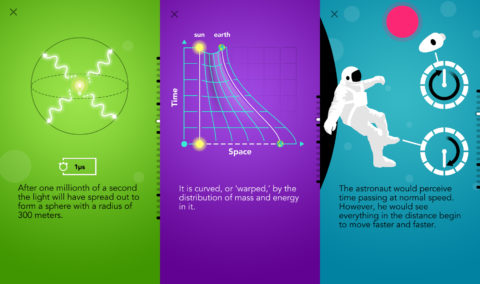
Stephen Hawking’s Pocket Universe
Again, it’s your iPhone that enables this to happen, through a combination of portability, helpful illustrations, personal progress records, sharing capabilities, and an integrated glossary. Pocket Universe might not quite deliver on the claim to explain “everything you want to know about the universe”, but it comes closer than the paper form would, and showcases that now we’re hurtling along this path of transforming media, there’s really no going back.

